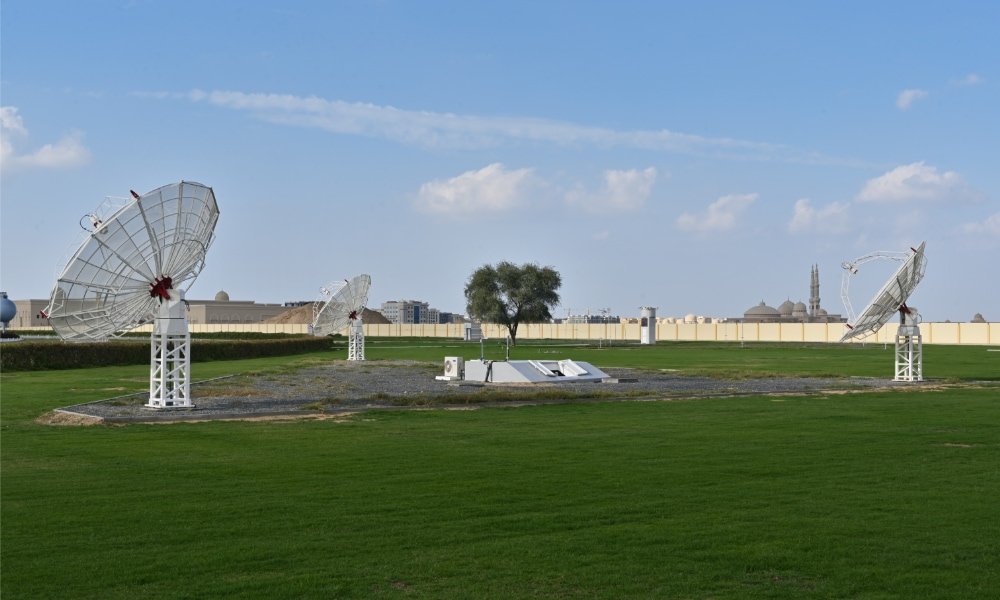Affordable radio interferometry with SPIDER MarkII radio telescopes
Affordable radio interferometry
Radio interferometry is the technique used by professional radio astronomers to create a single large radio telescope using multiple smaller antennas. Radio interferometry allows radio astronomers to obtain radio pictures with higher angular resolution, but up until now this technique has been used only in very expensive research instruments….
Today we present our next challenge – To develop the first affordable radio interferometry system for radio astronomy with SPIDER MarkII radio telescopes!
Radio interferometry and angular resolution
Exploring the Universe by means of detecting radio waves has many advantages, like performing radio astronomy during daytime and in adverse weather conditions. However, since the angular resolution of a telescope is directly proportional to the wavelength, a radio telescope has an angular resolution much smaller than an optical telescope. For example, the angular resolution is calculated by this formula:
θ = 2.5 x 105 * (λ/D)
where θ is in arcseconds and λ (wavelength) and D (telescope diameter) are in meters.
Considering an optical telescope with 50cm diameter (0.5m) with medium value of 550nm of λ (5,5×10-7 m), the theoretical angular resolution is:
θ = 2.5 x 105 * (5.5×10-7 / 0,5) = 0.275 arcseconds
If we want to have the same angular resolution with a radio telescope recording 21cm wave length, we’ll need to solve this equation:
0.275 arcseconds = 2.5 x 105 * (0.21 m /D)
And this bring us to a diameter of 190909 meters. This means, in order for a radio telescope to have the same angular resolution of a 50cm optical telescope, the antenna would need to be 191 km in diameter, far too large to actually build! However, by using radio interferometry we can effectively create a single telescope as large as the distance between the two farthest radio telescopes composing the array.

Affordable radio interferometry with compact radio telescopes
Many radio telescopes are designed as an array of more compact antennas instead of a single massive instrument. Examples can be found at the new Atacama Large Millimeter Array (ALMA) in Chile, composed of many 7 and 12 meter diameter antennas as well as the Very Large Array (VLA) in New Mexico (USA) that uses 27 antennas, each 25 meters diameter. SPIDER radio telescopes use smaller antennas, with diameters ranging from 2.3 to 5 meters – This is one of the reasons that makes the SPIDER so affordable, even within the reach of schools, universities or a science museum budget.
As you begin building an antenna with a diameter larger than the 5 meter model used in the SPIDER 500A MarkII, the costs of the radio telescope increase dramatically due to the massive mount that would be required not only to precisely move such an antenna (precise movement is critical in radio astronomy applications) but to also safely handle any adverse weather conditions, like the more compact SPIDER radio telescopes. When we studied the possibility of developing a larger radio telescope, we found that the manufacturing costs of a 8 meter model would be more than 3 times that of the SPIDER 500A MarkII radio telescope… Clearly radio interferometry is the solution.

When we developed the SPIDER line of radio telescopes, we brought to market the first line of affordable, professional, compact radio telescopes developed specifically for radio astronomy. Now we want to extend this development to radio interferometry to create complete arrays of radio telescopes, allowing you to do radio interferometry with ready-to-use SPIDER MarkII systems! Since the start of this challenge, we already complete development of these:
- Development of a Radio-over-Fiber Device that, by replacing standard RF cables, maximizes the signal from SPIDER MarkII antennas, allowing of sending data over medium/long distances between the LNA and the receiver.
- Development of the Mount-over-Fiber Device that, by connecting the antenna to remote control room with a fiber optic cable, it allows the remote control of SPIDER MarkII radio telescopes from very long distances, up to 2km.
Now we’re developing the next devices that are needed for the SPIDER MarkII radio telescopes to be used for interferometry:
- Development of a new backend for SPIDER MarkII radio telescopes, based on a high-performance FPGA that will support various applications: in addition to performing high data rate time-domain acquisitions for interferometry applications and pulsar detection, it will also serve as a high-resolution spectrometer and for total power measurements in single dish mode. It will enable the application of RFI mitigation techniques or sub-channel filtering to optimize performance and will be equipped with systems for signal synchronization via PPS and external clock.
- Application of a software correlator for interferometry with SPIDER MarkII radio telescopes: We have opted for a software correlator over a hardware one to enhance flexibility and reduce costs. Our aim is to ensure the signals acquired by our digital backends are compatible with the professional software correlators already used in research. This will enable us to perform interferometry with the SPIDER MarkII radio telescopes in a manner that is similar, yet simpler and more cost-effective, compared to large professional radio telescopes.
The developments described above are Research and Development efforts, and therefore, we do not have a precise release date at this time. However, PrimaLuceLab is actively developing devices described above and will make them available once they meet our performance standards.
If you like to know more about our affordable radio interferometry system for SPIDER Mark II radio telescopes, contact us. |
.
